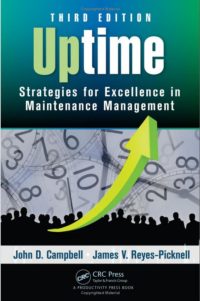Like the human body, our plant and mobile equipment will break down if it’s not looked after. If we exercise and push ourselves harder, we gain strength. Unlike our biological bodies that can self-repair, our physical plants and mobile equipment do NOT strengthen if we overload them. Yes, they will tolerate some abuse but not for long. Machinery, unlike biological organisms, can not recover from damage on its own. It needs a bit of basic care. Basic care is all about taking care of our physical assets so they continue to do what we need them to do. Take care of their fluids (e.g.: oils, coolants), keep them from running hot (e.g.: clean heat transfer surfaces like cooling fins), and keep them free of contaminants that damage their insides (e.g.: keep moisture and dirt out). In the “Uptime Pyramid of Excellence,” the pinnacle is “Choosing Excellence”. That choice implies an active application of all of the model’s components. It’s a journey, not a destination.
You can choose excellence in only one area like planning, scheduling, precision maintenance, etc., and expect some improvement, but you cannot expect consistently high performance. It is essential to master the basics. One of the most basic activities is to keep in compliance with regulatory requirements. Keep in mind that regulations, like standards, set minimum hurdles that must be crossed, not high bars. Beyond that, you begin to expand in the direction of excellence.
Our physical assets are needed, first and foremost, to deliver uptime for production and service delivery. With more uptime, we have greater revenue-generating potential. Let’s assume you are complying with all the regulations applicable in your industry and jurisdiction.
We also want our equipment to operate efficiently so we don’t consume excessive amounts of energy (i.e.: fuel, electric power). Basic care helps achieve that efficiency – it entails meeting minimal standards and, if you choose, exceeding them.
Without a minimal maintenance program in place, you can expect to suffer failures, unplanned outages, and other disruptive events. As the saying goes, “An ounce of prevention is worth a pound of cure”. It is a given that it is far cheaper to prevent a failure than to repair it. There are a variety of proactive tactics and technologies that can be used to prevent failures from occurring and to predict when some failures that cannot be prevented, will eventually progress beyond tolerable limits. These activities buy us time to plan contingency action to minimize the consequences of those pending failures.
There are also the options of redesigning the asset to eliminate the failures – usually, that’s pretty expensive to do. An running to failure is always an option, although not always the most advisable. Nevertheless, all of these tactical approaches are acceptable in the right circumstances.
Understanding the nature of failure mechanisms, their consequences, and the available failure management tactics enables us to make intelligent decisions about the best course of action. Basic care is a start at doing the right work. Beyond that requires a more in-depth understanding of failures, reliability, and the various maintenance tactics to achieve it. However, basic care alone isn’t enough. To sustain it you need competence in work management and good coordination with your supply chain for the timely supply of needed parts and materials.
In our next blog, we’ll explore part five of our 10 part series “Uptime Insights: Building Excellence in Materials Management”


